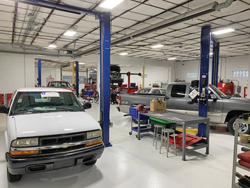Success after high school is focus of the district’s new auto tech training center
by Martin McConnell
When Chadwick Groom was hired to replace longtime Hudson High School automotive technology teacher Gary Reynolds last summer, he knew he had big shoes to fill.
Groom, a former senior technician at Toyota, however, leaned into his expertise, his desire to teach others and the opportunity to be part of a freshly launched auto tech training facility to rise to the task.
The Hudson City School District opened its new auto tech training facility and skill trade school, located at 4050 State Rd., in the fall, following about three months of facility updates. The program used to be run out of a garage in the parking lot of the old middle school.
“[The new building] used to be an automotive repair facility called Gearheads,” Groom said. “We acquired the building this past spring, and we did a full renovation of the facility. Windows, doors, lighting, the floors were redone in the shop area, and we purchased some new equipment.”
Students learn auto tech theory and do other coursework in a classroom area at the front of the facility. Hands-on lessons and car repairs take place in a shop located in the back.
The building serves not only the Hudson students but those from other high schools in the Six District Educational Compact, which includes Kent, Stow-Munroe Falls, Woodridge, Tallmadge and Cuyahoga Falls. Groom’s two-year program aims to prepare participants for both college and entry-level jobs in auto repair. Students spend half of their day at the trade school and half at their community high school.
“The goal is to set them up with opportunities for [college credit],” Groom said. “There is also a physics course and a math course that is embedded in this.”
Students in the program can graduate with 14 hours of college credit that can then be applied either towards a certificate or an associate’s degree.
In the classroom, much of the focus is put on students preparing for Automotive Service Excellence certification tests. According to Groom, there are eight certifications that a student can earn to be considered a master technician.
“Basically, if you can gain those certifications, it tells an employer that you know what you’re talking about,” Groom said. “About 30% of our time is spent up here learning theory, and doing review, guided notes and then the rest of it is practical. … I’ve got a task list with probably 300-400 competencies that we try to get them to master.”
Groom emphasizes automotive theory in his teachings. Practical work in the back of the shop certainly helps, but he feels that being intimately familiar with the theory can help students become even better auto technicians.
“Understanding the theory and the operating principles behind these systems allows you to do more than just remove and replace parts,” he said. “It allows you to really probe and diagnose a customer’s concern.”
The new trade school also prides itself on a work-release program. Groom noted that six out of the 11 students from his morning class already have a job of some kind at an auto shop in the area.
“Their senior year, they’ll be eligible to go out into the industry on a work placement program. That starts their second semester of senior year,” Groom said. “This group is already off to a good start.”
‘Shoo-ins’
Groom said the morning and afternoon groups have become tightly-knit groups since the school year began. He spoke highly about his students, but specifically gave high praise to Kyren Carroll and Logan Gibson.
Carroll is a junior in the program and has been working on cars with his father since he was 7 years old. Groom noted that Carroll’s experience makes him one of the students that he trusts the most and one that he knows can help other students who might need it.
“Ever since I was in elementary school, after every day [of school], I did tire rotations, brakes, maintenance,” Carroll said. “I’d watch [my dad] do oil changes, and then the next time, when another car would come in, I’d do it.”
Groom singled out Gibson as a “coach” for other students as well. He feels comfortable giving Carroll and Gibson the reins when he leaves the room and trusts them to make sure any job is done by the time he returns.
“I’ve always had a passion for auto mechanics since I was little. “It’s been one of the things I always wanted to do,” said Gibson. “I teach my dad stuff all the time from auto mechanics.”
Groom stressed that the auto technician industry is an undervalued market that is desperate for workers. About 69,000 positions open up in the industry each year.
“The things you’re learning here, you are a walk-in, a shoo-in, anywhere you go,” Groom said. “The only limiting factor right now is age.”
Mary Jane Stanchina, executive director of the Six District Educational Compact, is one of the driving forces behind renovating and opening the new facility. With 28 career technical education (CTE) programs currently operating throughout the Six County Educational Compact, Stanchina believes in offering students as many opportunities as possible.
“When we send these students out for an internship, or for work-based learning, or et cetera, the employer knows that these students can get it done,” Stanchina said. “Our employers in this area know about our CTE programs and the work that they do, and that they can fulfill what the employer needs.” ∞

